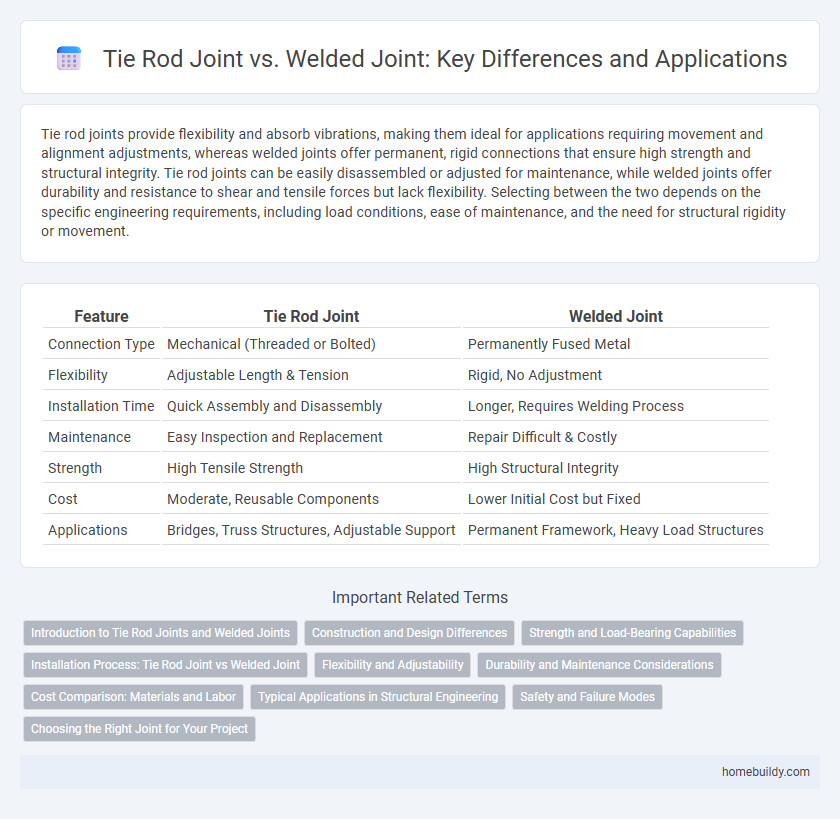Tie rod joints provide flexibility and absorb vibrations, making them ideal for applications requiring movement and alignment adjustments, whereas welded joints offer permanent, rigid connections that ensure high strength and structural integrity. Tie rod joints can be easily disassembled or adjusted for maintenance, while welded joints offer durability and resistance to shear and tensile forces but lack flexibility. Selecting between the two depends on the specific engineering requirements, including load conditions, ease of maintenance, and the need for structural rigidity or movement.
Table of Comparison
| Feature | Tie Rod Joint | Welded Joint |
|---|---|---|
| Connection Type | Mechanical (Threaded or Bolted) | Permanently Fused Metal |
| Flexibility | Adjustable Length & Tension | Rigid, No Adjustment |
| Installation Time | Quick Assembly and Disassembly | Longer, Requires Welding Process |
| Maintenance | Easy Inspection and Replacement | Repair Difficult & Costly |
| Strength | High Tensile Strength | High Structural Integrity |
| Cost | Moderate, Reusable Components | Lower Initial Cost but Fixed |
| Applications | Bridges, Truss Structures, Adjustable Support | Permanent Framework, Heavy Load Structures |
Introduction to Tie Rod Joints and Welded Joints
Tie rod joints consist of mechanical fasteners such as threads and nuts, allowing adjustability and disassembly in structural and automotive applications. Welded joints create a permanent bond between components by melting and fusing materials, providing high strength but limiting flexibility. Selecting between tie rod joints and welded joints depends on the requirements for adjustability, strength, and maintenance in the specific engineering design.
Construction and Design Differences
Tie rod joints feature mechanical connectors such as threads, rods, and spherical bearings allowing adjustment and flexibility in structural alignment. Welded joints create rigid, permanent connections by melting metal parts together, enhancing strength but limiting adjustability. Design differences emphasize tie rod joints for tension control with ease of maintenance, while welded joints prioritize structural integrity and rigidity in fixed frameworks.
Strength and Load-Bearing Capabilities
Tie rod joints provide superior flexibility and strength by allowing slight angular movement, effectively distributing dynamic loads and reducing stress concentration compared to welded joints. Welded joints, while offering high initial strength, are more susceptible to fatigue cracks under repeated loading due to rigidity and stress risers at the weld bead. In high-load applications, tie rod joints enhance load-bearing capabilities by accommodating structural shifts, ensuring longer service life and improved durability over welded connections.
Installation Process: Tie Rod Joint vs Welded Joint
The installation process of a tie rod joint involves precise alignment and secure bolting or clamping, ensuring flexibility and ease of adjustment during assembly. Welded joint installation requires skilled welding techniques to create a permanent, rigid connection, often demanding stricter quality controls and longer cooling times. Tie rod joints typically offer quicker installation and maintenance compared to the labor-intensive and less adjustable welded joints.
Flexibility and Adjustability
Tie rod joints offer superior flexibility and adjustability compared to welded joints, allowing for precise alignment and movement in mechanical systems. Welded joints provide rigid, fixed connections that lack the capability to accommodate dynamic adjustments or absorb vibrations effectively. This makes tie rod joints ideal for applications requiring frequent tuning and adaptability under varying load conditions.
Durability and Maintenance Considerations
Tie rod joints offer superior durability due to their ability to absorb vibrations and dynamic loads without compromising structural integrity, unlike welded joints which may develop stress fractures over time. Maintenance of tie rod joints is more straightforward, as they can be inspected and replaced individually, reducing downtime and repair costs. Welded joints require thorough inspection for cracks and corrosion, often necessitating specialized equipment and techniques for effective maintenance.
Cost Comparison: Materials and Labor
Tie rod joints typically involve precision-machined components and require skilled labor for assembly, resulting in moderate material costs but higher labor expenses compared to welded joints. Welded joints generally use raw materials like steel rods and consume less labor time due to simpler fabrication processes, lowering overall labor costs but potentially increasing material waste and post-weld treatment expenses. The cost-effectiveness of tie rod joints versus welded joints depends on production volume, quality requirements, and long-term durability considerations.
Typical Applications in Structural Engineering
Tie rod joints are commonly used in structural engineering for tension members in bridges, trusses, and roof systems where precise adjustability and load distribution are crucial. Welded joints, by contrast, are typically employed in rigid frame connections and heavy steel frameworks where permanent, high-strength bonds are required to resist bending and shear forces. The choice between tie rod joints and welded joints depends on factors such as expected load conditions, need for flexibility, and maintenance considerations in the structural application.
Safety and Failure Modes
Tie rod joints provide enhanced safety through their ability to absorb and distribute stress, reducing the risk of sudden failure compared to welded joints that can develop cracks due to heat-affected zones. Welded joints are more susceptible to fatigue failure and brittle fractures, especially under cyclic loads, whereas tie rod joints allow for easier inspection and maintenance, improving overall structural integrity. In critical applications, tie rod joints minimize failure modes by accommodating slight movements, preventing catastrophic breakdowns common in rigid welded connections.
Choosing the Right Joint for Your Project
Tie rod joints offer flexibility and ease of adjustment, making them ideal for projects requiring precise alignment and regular maintenance, whereas welded joints provide superior strength and permanence suited for heavy load-bearing structures. Selecting between a tie rod joint and a welded joint depends on factors such as load requirements, environmental conditions, and the need for future modifications. For applications involving dynamic stress or frequent disassembly, tie rod joints optimize durability and serviceability, while welded joints excel in long-term stability and rigidity.
tie rod joint vs welded joint Infographic

 homebuildy.com
homebuildy.com